Bradford VTS Online Resources:
Teaching & Learning
Educational Theory
Engaging Adult Learners
How Adults Learn
Adult Learning
Androgogy, Transformational Learning & Experiential Learning
Cognitivism
Behaviourism
Constructivism
Principles of constructivism
Behaviorism, Cognitivism, Social Constructivism
Cognitive Load Theory
Is Educational Theory boring?
Of course it’s not! But, then I would say that?
But why do so many people find it boring?
- Because it is taught in a dull way
- Because the stuff is written by academics who write in a dull way
- And those academics like to big themselves up by using big words for rather simple but important concepts.
But the only thing I would say is that these concepts, once you understand them, will transform the way you teach. That’s why it’s worthing knowing something about them. Hopefully, this page will demistify some of that by presenting some of the basic theory that I think all GP Trainers should know.
1. Knowles' Principles of Adult Learning (1984)
There are two main ways to teach people
- in a Child-like way (pedagogy) – where the learner is spoon fed everything by the teacher
- or an Adult-like way (Andragogy) – where learner is not spoon fed, but instead guided in their learning in order promote change.
So, in a pedagogic classroom, the learners just sit there, absorb the information that is being churned out by the teacher and then they leave. The teacher decides everything – what the content is, how it will be structured, displayed etc. The learner is passive.
In an androgogic classroom, the teacher becomes a facilitator. Learners are encouraged to engage in dialogue – to question, to quiz, to explore, to discuss, to work out (problem-solve) etc. The learner and teacher work together to determine the content, how to engage with the content. The learner is active as is the teacher.
In medicine, we try to go for the andrologic approach, because we want the learners to learn things for themselves. We want any change to come from themselves. Change from within is more likely to be internalised and adopted than change which is forced externally. It’s interesting that Androgogy is the term used – because children can learn in this way too! It’s not just for adults.
Also, do NOT see androgogy as the best way to teach and pedagogy as old fashioned and rubbish. They are both good teaching approaches – which one you choose to do depends on what you are trying to teach. Teaching a class of 100 trainees in 1 hour about an update in Dermatology – a pedagogic slide show with the lecturer speaking and others listening may well be the best way with the time given. Andragogy and pedagogy are best seen NOT as separate entities but as two ends of a spectrum: what methods of each you wish to employ depends on your target audience and the educational objectives set.
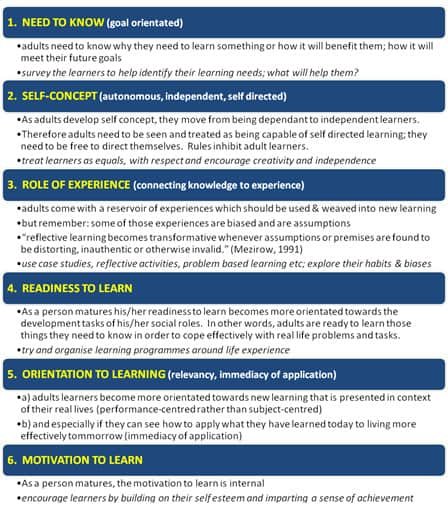
Knowles: the father of androgoic learning. He devised some basic principles that will promote adult learning. If you want to know how to promote adult learning in your teaching, adopt these principles. They are displayed for you above.
Androgogy
6 tips for adult learning
Adult Learning Principles
The Six Adult Learning Principles
The 3 Cs of Constructivism
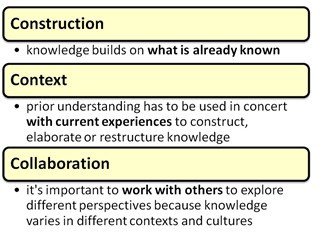
Constructivism is based on the theory that people learn best by actively constructing their own concepts, ideas and understanding usually by fitting new information together with what they already know. It’s emphasis is on the learner rather than the educator. For example, if you give a group of adults a novel to read, and then ask them to describe it, they’ll come up with their own different interpretations. Therefore, one of the most fundamental principles of constructivism is that there are no universal truths and that meaning is socially negotiated* (Duffy & Cunningham, 1996, and Windschitl, 2002). Constructivism emphasises the social nature of learning and the rich learning the group environment provides us with. It’s androgogic in nature.
Vico’s verum factum principle (1710) states that truth is verified through creation or invention and not, as per Descartes’ previously held belief, through mere observation.
Gibb's Reflective Cycle (1988)
Gibb’s cycle is a neat little tool because it provides you with a structure for tackling any case discussion learners have experienced – especially the emotionally charged ones. It encourages learners to reflect on what happened so that they can somehow make sense of the experiences. But reflection is not enough: one has to put the new learning and understanding into practise.
How to Use It
- Use the headings below to structure the reflective discussion around any experiential event.
- Use it to encourage trainees how to write up learning events for their e-portfolios.
- Make sure the learners are not too hard on themselves: the evaluation phase should help you tease what was GOOD and bad about the experience.
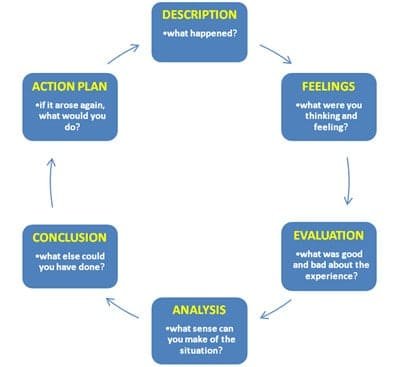
Kolb's Learning Cycle (1984)
Kolb’s learning cycle is another model that you can use in a similar way to Gibb’s. Go through the four main areas with trainees to help them reflect and learn from their experiences.
Remember Mezirow’s principles: learning cannot happen without reflection.

How to teach via Kolb
Motivational Theories: Maslow's Heirarchy of Needs
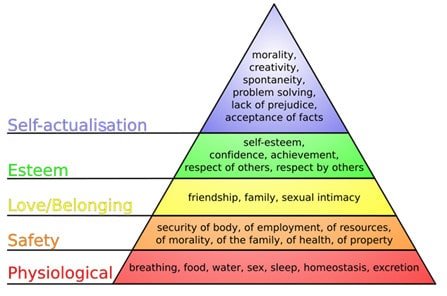
The original Maslow’s Heirarchy of Needs
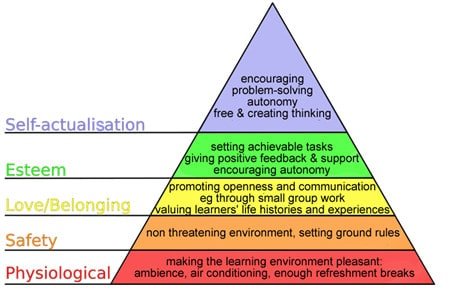
Maslow’s heirarchy applied to the classroom
(adapted from Harkin et al, 2001)
Maslow hierarchy is a useful model in terms of tackling the “valuing” arm of motivation. It basically says that each of us is motivated by needs and that each of the “needs” in the diagram above must be satisfied in order for higher levels to be met. The levels can be divided into physiological needs and psychological needs. If lower levels are all of a sudden made unstable (e.g. through health and disease) then maintaining the higher levels become less important to us.
At the top of the structure is something called self actualisation which is all about fulfilling one’s own unique potential through morality, creativity, problem solving and expressing own ideas/points of view. In essence, people become themselves more fully when they are at the self-actualisation level. It is at this level that trainees truly engage in their own learning and place a value on what is taught to them. This cannot happen if the levels below self actualisation are not met.
A trainee who has deficiencies in any of the levels like being loved or having a sense of belonging, are unlikely to have a strong motivation to neither yearn for knowledge nor be open to new ideas and being creative: it hinders effective learning. Even for those of us who live in the “First World”, one must be careful about overlooking physiological and safety needs and assuming they are automatically satisfied. For instance, consider the trainee who has not had enough sleep because he’s working night shifts (or moonlighting) for extra cash as well as trying to get an education. Maybe he needs the extra cash because he’s in severe debt or has three relatively young children. How motivated do you think he will be the next day at your teaching session with eyes half open?
This model is only a concept to help guide you. It is not a fully responsive model (in other words it doesn’t cater for every life situation) and therefore it would be wrong to use it so rigidly.
- For instance, someone who going through marital difficulties (love/belonging) does not mean they will not respect others (esteem).
- And life is not as linear as Maslow’s model would suggest: a person who engages in helping others e.g. at the homeless centre in the evenings (transcendence level – a level beyond self actualisation) might improve his/her poor self worth or depression (the lower esteem level).
- Humans are complex beings and who will move up and down this hierarchy throughout their lives; therefore you have to be flexible in its application.
So, when you have a trainee in difficulty, or one that just doesn’t seem motivated, or one whose motivation you want to push more, think Maslow and his heirarchy of needs.
Grows model for Staged Self-Directed Learning (1991)
This model is based on Hersey and Blanchard’s work into ‘situational leadership’ (in ‘business management’) and translated by Gerald Grow to the educational setting. Its basic principle is that teaching is situational: the style of teaching needs to be matched to the learner’s ability and motivation at the time (termed “readiness”).
Grow proposed four learner styles and four matching teacher styles. You can only move trainees to the next level if you figure out where they currently are and match them first. The four levels are described in the tableon the right. Problems occur when dependent learners are mismatched with non-directive teachers and when self-directed learners are mismatched with highly directive teachers.
Therefore, the purpose of this model is to help you
- Identify where your current learners are in terms of self-directedness
- Match your educational activities/session to that level and then
- Facilitate their progression to the next higher level.
Student | Teacher | Examples | Possible Teacher Pitfalls | |
Stage 1 | Dependent | ‘The Expert’ | Coaching with immediate feedback. Drill. Informational lecture. Directive and pedagogical in nature. | Can be too controlling that stifles learner initiative and enhances dependency. |
Stage 2 | Interested | Motivator | Inspiring lecture plus guided discussion. Goal-setting and learning strategies. | May end up entertaining well but leaving learners with little learning skills and/or motivation. |
Stage 3 | Involved | Facilitator | Discussion facilitated by teacher who participates as equal. Collaborative small group work. Non directive and truly andragogical. | May end up accepting and valuing anything from anybody; students then show little respect. |
Stage 4 | Self-directed | Delegator | Internship, dissertation, individual work or self-directed study-group. Creativity. Mentorship. | May withdraw too much and thus lose touch and fail to monitor progress. |
Good teaching does two things: a) it matches the student’s stage of self-direction, and b) it empowers the student to progress toward greater self-direction. Remember, moving the learner onto the next stages requires time; it doesn’t happen overnight! You need patience.
Tuckman's Group Dynamics (1965)
Whenever I am facilitating a small group, I am always mindful of Tuckman on group dynamics. If you’re going to be involved in teaching small groups it’s imperative you have some understanding about group dynamics (how groups work).
Tuckman’s model helps you understand ‘how groups develop’ thus helping you to help a group function more effectively.
According to the model, groups that are going to be in existence for a while (i.e. not ‘one offs’) go through four stages as they come together and start to function. But how long they spend at each stage depends on how well they know each other: if there are lots of familiar faces, less time might be spent on the first three stages and the group quickly progresses to the desired performing stage. But that’s not to belittle the first three stages: it’s important for groups to go through each stage otherwise they might ‘perform’ . Groups often become dysfunctional (stuck in the storming stage) if the facilitator has not allowed enough time and attention for the forming stage.
By the way, Tuckman’s model can be applied to teams as well as small groups.
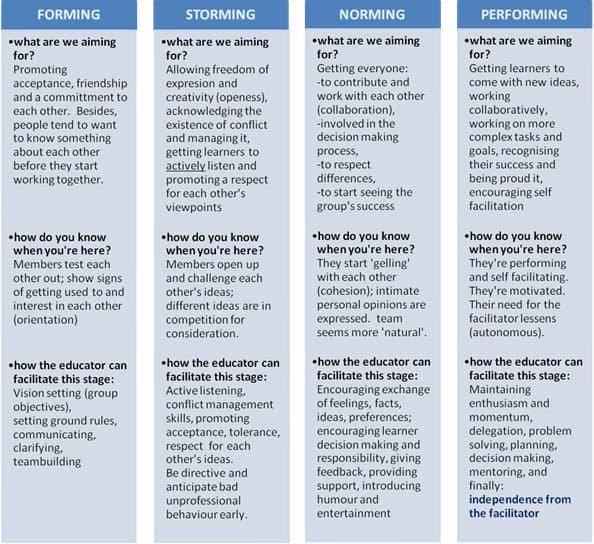
A fifth stage, adjourning (or some call mourning) was added in 1975: ten years later. This is where the group’s life span comes to an end and they split. There may be some feeling of loss amongst members. However, it still doesn’t feature in most visual representations of Tuckman’s model because he wanted to focus on how groups develop, not how they end; it’s the former that is going to help us as facilitators.

